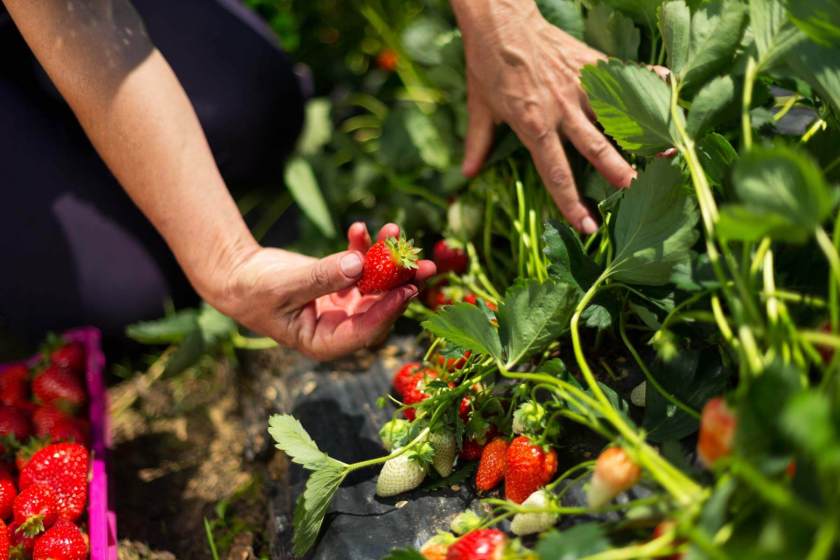Juicy, sweet strawberries fresh from your garden are one of summer’s simple pleasures in Alabama While strawberries thrive in the state’s warm climate, growing them does require some special considerations Follow these tips for a successful strawberry harvest in your own backyard.
Choosing a Site
Strawberries need full sun and well-drained soil to produce a bountiful crop. Find a spot that gets at least 6-8 hours of direct sun daily. Morning sun is especially important to dry dew from the plants, preventing disease.
Raised beds are ideal for improving drainage in heavy clay or compacted soils. Building the bed at least 6-8 inches high gives roots room to spread Mix in compost or other organic matter to enrich the soil
Container growing is also an option for strawberries. Use pots at least 12-14 inches wide and 10 inches deep for each plant. Make sure containers have drainage holes and use a quality potting mix, not garden soil.
Selecting Varieties
Choose June-bearing varieties suited to Alabama’s climate. Earliglow, Camarosa Chandler Festival, and Sweet Charlie are excellent selections. Everbearing or day-neutral berries don’t perform as well in the state’s long summers.
Consider timing too – early, midseason, and late varieties extend the harvest. Mixing types spreads out production for fresh eating over 2-3 months.
When to Plant Strawberries
Fall is the best time to plant strawberries in Alabama. Set plants out 6-8 weeks before the first expected frost, usually in October. This enables roots to establish before cold weather arrives.
Spring planting is risky since plants haven’t had time to mature before summer’s heat. Focus on preparing beds in spring for a fall planting.
Containers can be planted 2-4 weeks later than the ground. The potting mix stays warmer than garden soil into late fall.
How to Plant Strawberries
Whether in beds or containers, proper planting technique ensures success:
-
Space plants 12 inches apart in rows 24-36 inches apart. Offset each row for efficient use of space.
-
Dig holes deep enough that the crown sits just above soil level. Crown rot can occur if buried too deep.
-
Backfill soil and gently firm around roots. Water thoroughly after planting.
-
Remove flowers the first season so plants direct energy to establishing roots, not fruit.
-
Apply 2-3 inches of mulch like straw or pine needles after planting. Replenish as it decomposes.
-
Water 1-2 inches per week during the first year, adjusting for rainfall. Avoid wetting the leaves.
Ongoing Care
The work doesn’t stop once your strawberries are planted! Follow these tips for the best harvests:
-
Weed regularly to prevent competition for water and nutrients. Mulch helps smother weeds.
-
Fertilize monthly with a balanced organic or chemical fertilizer to replace nutrients used for fruiting.
-
Prune off old leaves and thin crowded plants each summer. Promote air circulation and sun exposure.
-
Protect flowers from late spring frosts. Cover plants or sprinkle with water to insulate against freezing.
-
Pick berries every 2-3 days during peak season. Avoid leaving overripe fruit to rot on the plants.
-
Renovate beds after the final harvest by mowing leaves and removing old plants. Renew with fresh plants every 3-5 years.
Growing luscious strawberries in Alabama is easy with the right site, variety, and care. In just one season, you can enjoy homegrown berries that rival any store-bought fruit. Get your fill of sun-sweetened strawberry flavor – plant some this fall!
How do strawberries grow in strawberry jars?
Strawberries do well in jars, but you will have to water them often and they won’t produce as many fruits as they would in the ground because the soil isn’t as full. Strawberry jars are a fun novelty and are especially useful for small patio and condo gardens.
Is the Arizona sun too intense for strawberries?
In your area, give them shade through the summer months.
How to Grow Strawberries in Alabama
FAQ
When should I plant strawberries in Alabama?
Why do farmers plant onions with strawberries?
When to plant strawberries in Alabama?
In Alabama, strawberries are planted in September or October for harvesting the following year. Strawberries are one of the easiest plants to grow, and will reward your efforts with delicious fruit in the late spring or early summer. Loosen the garden soil with a shovel to a depth of 12 inches and amend with compost to improve drainage.
Which strawberries grow best in Alabama?
Cardinal and Earliglow are two varieties of strawberries that thrive in Alabama’s humid climate. Choose a planting location in your garden that receives at least six hours of sun every day. In Alabama, strawberries are planted in September or October for harvesting the following year.
How do you grow strawberries in Arizona?
Strawberries in Arizona need afternoon shade. Water strawberries every day in the summer. Mulch strawberries well. Strawberries are salt-sensitive, making them difficult to grow in Arizona’s salty soil. Regular deep watering can help wash salts from the soil. Plant strawberries in the low desert of Arizona from mid- September through January.
How do you grow a strawberry plant?
If necessary, amend your soil before planting. If soils in your area are naturally alkaline, it is best to grow strawberries in half-barrels or other large containers filled with compost-enriched potting soil. Raised beds are a particularly good option for strawberry plants. Practice crop rotation for the most success.
- The Ultimate Guide to Growing Strawberries in Raised Beds - August 8, 2025
- No-Dig Garden Beds: The Easiest Way to Grow a Beautiful Garden - August 6, 2025
- How to Protect and Preserve Wood for Raised Garden Beds - August 6, 2025

